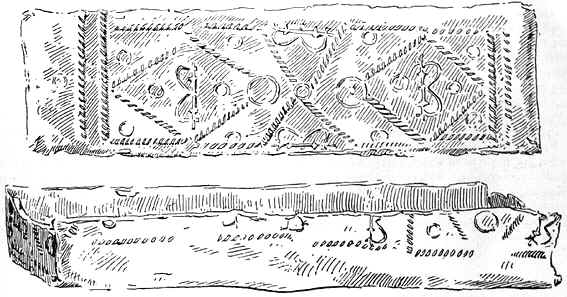Victoria
County History of Kent Vol. 3
1932 - Romano-British
Kent - Towns - Page 97
|
a glass phial and was associated with a
double-handled glass vessel bearing the stamp OBINI
in relief upon the base. This coffin is now in the Maidstone
Museum. In 1871 a fourth leaden coffin, lying with its head to
the south, was found with elaborate ornamentation of’ Medusa
heads,’ lions and vases containing torches—symbols which
probably had a Mithraic significance. Outside the coffin and
at its head was a green glass jug of a type which occurs on
1st-century sites, but is here presumably at least a century
later. Upwards of four other leaden coffins associated with
pottery, jet pins, etc., have been found on the same site. It
is noted that some of the leaden coffins had been ‘enclosed
in planks of wood, bolted together with clenched bolts of
iron, and further fastened with stout iron bands’ (G. Payne,
Collectanea Cantiana, 23; C. R. Smith, Collect. .
Ant. vi, 263).
(2) Some 300 yds. north of Bexhill cemetery, in a
corner of the field by the last stile before the marshes are
reached below Kemsley Downs, several urn-burials were found in
1889—90 on the right-hand side of the path. Each group of
urns was surrounded and covered by tiles (Proc. Soc. Ant. 2nd
series, xiii, 188). Nearby a Saxon inhumation-burial was
discovered (Arch. Cant. xviii, 207, and Payne, Coll.
Cant. 118).
(3) Sepulchral urns are somewhat vaguely recorded
from behind the White Hart Inn (Ibid.).
(4) To the east of the creek a richly furnished
cemetery has been found in a field at Bayford, on the eastern
side of the road leading from Crown Quay Road to Adelaide
Dock, Murston. The burials found in and after 1875 were in two
cases by inhumation, but mostly by cremation. Vessels of
pottery, glass and bronze were unearthed here, the bronze
vessels in particular |
|

Fig. 18. Leaden coffin from
Sittingbourne
(From G. Payne, Collectanea Cant. 54)
|
|
being unusually ornate. They include a
bronze lamp-stand with crescent-shaped handle, and ornamented
bronze jugs of 1st and early 2nd-century types (P1. XV, nos.
2, 3). Some of these objects are in the British Museum. It is
clear that the greater part of this cemetery was pre-Hadrianic.
Near the burials were found three burnt areas, associated with
iron nails, oyster-shells, tiles, animal-bones, etc., which
were thought to be the sites of funeral pyres, but may rather
have been those of hutments not necessarily coeval with the
cemetery (G. Payne, Collect. Cant. 44; Arch. Cant. xi,
47; Proc. Soc. Ant 2nd series, viii, 276; Journ.
Brit. Arch. Assoc. xxxiii, 263).
(5) A little to the north-east of the Bayford
cemetery, on the left of the private road leading to East
Hall, Murston, a further Roman cemetery or perhaps an
extension of the preceding was discovered 800 yds. south-east
of Murston Old Church in and after 1871. The burials seem to
have been wholly by cremation, with the possible exception of
a single skull which was, however, associated with 1st-century
glassware, and may therefore have been part of an incomplete
cremation. The burial-groups were, at least in some cases,
‘arranged in line from north to south’ and included
Pottery which seems to have been almost exclusively of about
the period 70—110 A.D. (G. Payne, Coll. Cant. :33 ; Arch.
Cant. x, 178). More burnt burials were found a few hundred
yards N. of Mere Court in 1924 (see Top. Index, s.v. Murston).
(6) About half a mile north of the preceding, in
1869, a Roman lead coffin decorated with rope moulding, bound
together with iron bands and containing the fragments of two
or three glass vessels ‘in one of which were the bones of a
very minute creature,’ was found 9 ft. deep in Eleven |
Previous
Page Page 97
Next Page
Back
to Towns page listings
Contents
Page
This website is constructed
by enthusiastic amateurs. Any errors noticed by other researchers will be gratefully received so
that we can amend our pages to give as accurate a record as
possible. Please send details to localhistory@tedconnell.org.uk
|